Evaluating Soil Amendment Effects on Rice in Queensland
VerifiedAdded on 2022/12/27
|14
|3730
|54
Report
AI Summary
This report details an 18-month field experiment conducted in Queensland to evaluate the effects of various soil amendments on rice production and soil characteristics in alkaline clayey soils. The study involved three treatments with different soil amendment application rates (0, 5.00, and 10.00 t.hm-2) at a depth of 25 cm prior to rice planting. The research aimed to determine how the amendments affected soil pH, bulk density, exchangeable sodium percentage, electrical conductivity, plant nutrients, and water-holding capacity. Results indicated that the soil amendments reduced soil pH and improved the soil's physical properties, leading to increased germination percentage, crop yield, and plant height, with the most effective treatment observed at the highest application rate. The findings highlight the potential of soil amendments to enhance the physiochemical features and nutrient balance of alkaline soils, thereby improving rice growth and yield.

ADVANCED SOIL MECHANICS
By Name
Course
Instructor
Institution
Location
Date
By Name
Course
Instructor
Institution
Location
Date
Paraphrase This Document
Need a fresh take? Get an instant paraphrase of this document with our AI Paraphraser
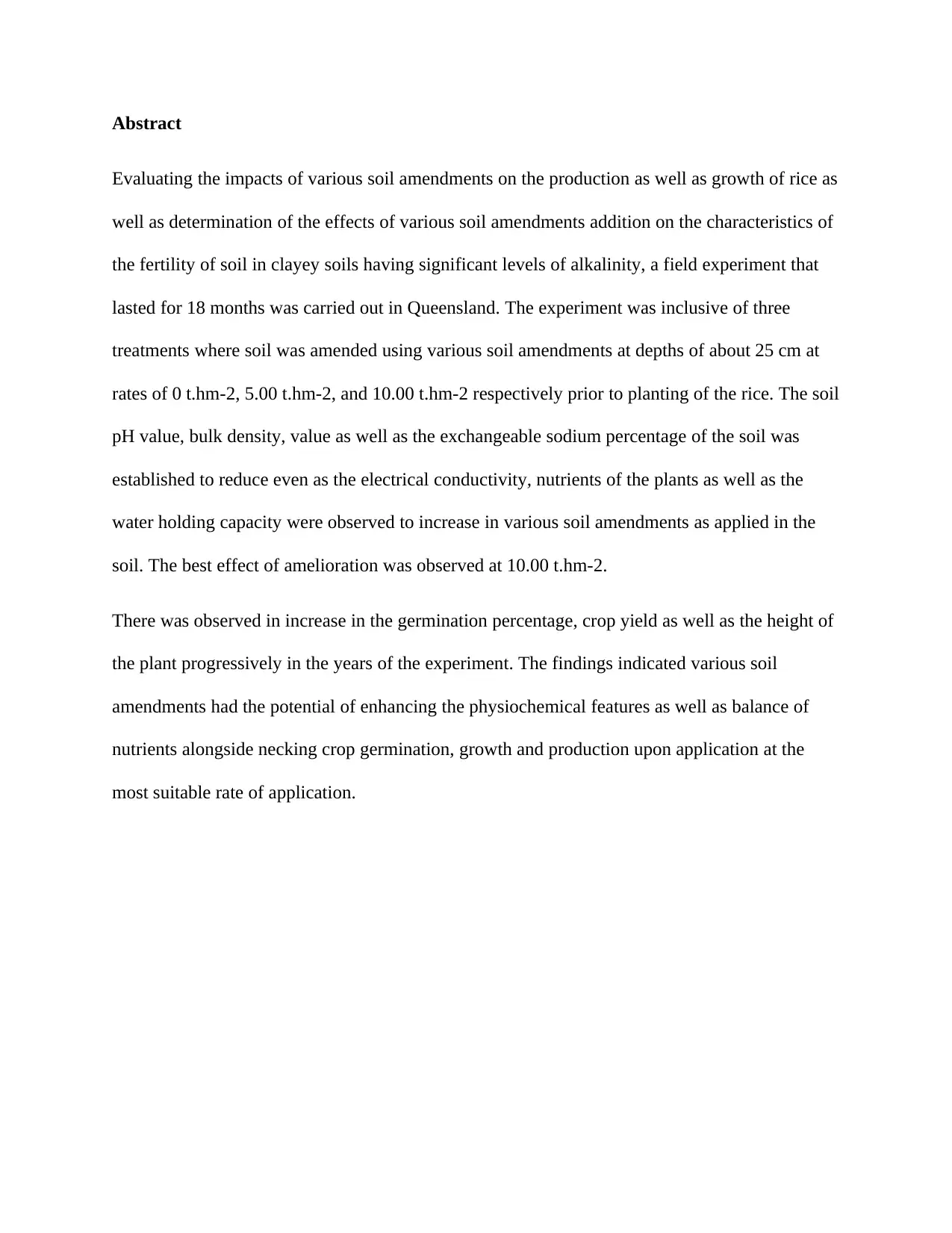
Abstract
Evaluating the impacts of various soil amendments on the production as well as growth of rice as
well as determination of the effects of various soil amendments addition on the characteristics of
the fertility of soil in clayey soils having significant levels of alkalinity, a field experiment that
lasted for 18 months was carried out in Queensland. The experiment was inclusive of three
treatments where soil was amended using various soil amendments at depths of about 25 cm at
rates of 0 t.hm-2, 5.00 t.hm-2, and 10.00 t.hm-2 respectively prior to planting of the rice. The soil
pH value, bulk density, value as well as the exchangeable sodium percentage of the soil was
established to reduce even as the electrical conductivity, nutrients of the plants as well as the
water holding capacity were observed to increase in various soil amendments as applied in the
soil. The best effect of amelioration was observed at 10.00 t.hm-2.
There was observed in increase in the germination percentage, crop yield as well as the height of
the plant progressively in the years of the experiment. The findings indicated various soil
amendments had the potential of enhancing the physiochemical features as well as balance of
nutrients alongside necking crop germination, growth and production upon application at the
most suitable rate of application.
Evaluating the impacts of various soil amendments on the production as well as growth of rice as
well as determination of the effects of various soil amendments addition on the characteristics of
the fertility of soil in clayey soils having significant levels of alkalinity, a field experiment that
lasted for 18 months was carried out in Queensland. The experiment was inclusive of three
treatments where soil was amended using various soil amendments at depths of about 25 cm at
rates of 0 t.hm-2, 5.00 t.hm-2, and 10.00 t.hm-2 respectively prior to planting of the rice. The soil
pH value, bulk density, value as well as the exchangeable sodium percentage of the soil was
established to reduce even as the electrical conductivity, nutrients of the plants as well as the
water holding capacity were observed to increase in various soil amendments as applied in the
soil. The best effect of amelioration was observed at 10.00 t.hm-2.
There was observed in increase in the germination percentage, crop yield as well as the height of
the plant progressively in the years of the experiment. The findings indicated various soil
amendments had the potential of enhancing the physiochemical features as well as balance of
nutrients alongside necking crop germination, growth and production upon application at the
most suitable rate of application.
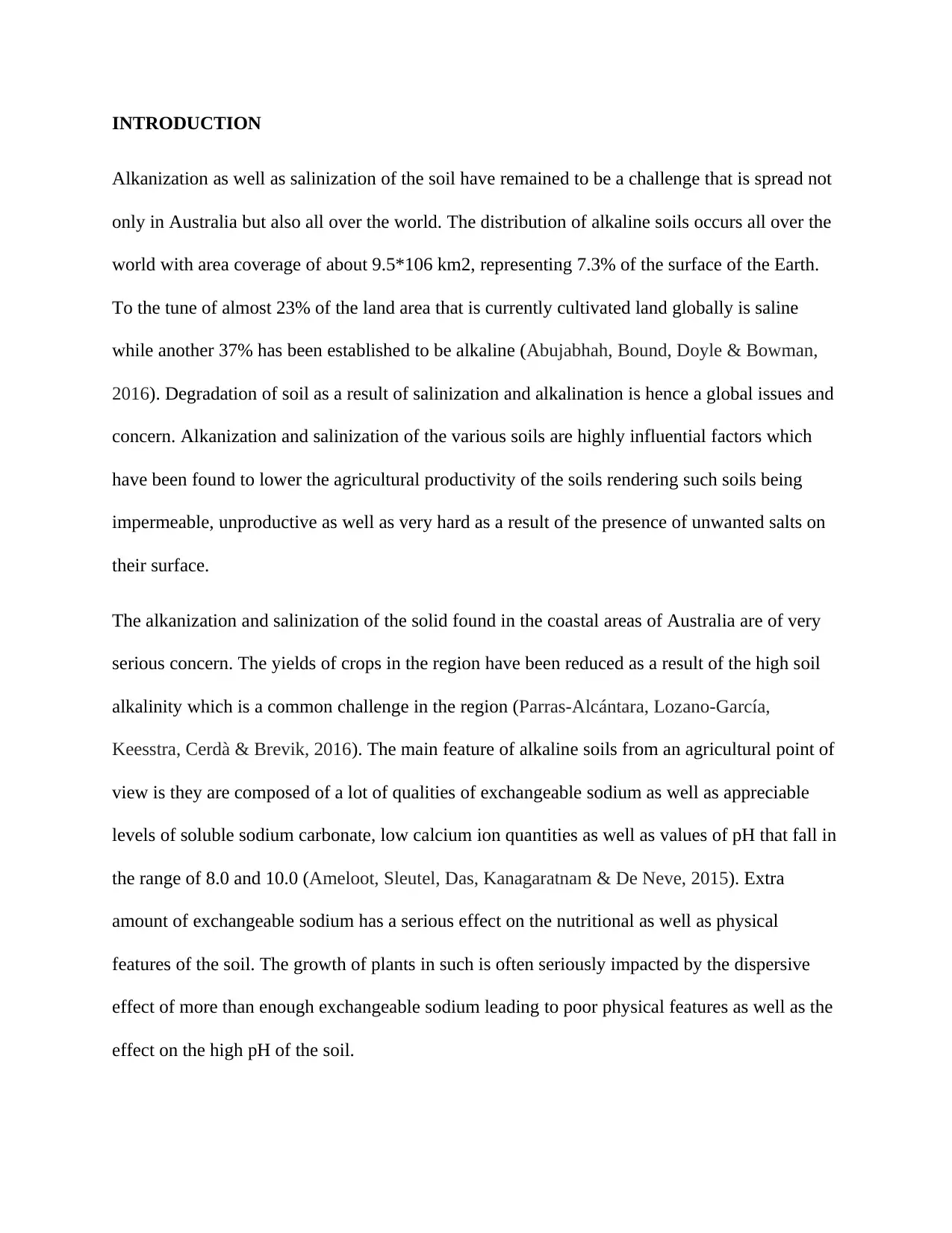
INTRODUCTION
Alkanization as well as salinization of the soil have remained to be a challenge that is spread not
only in Australia but also all over the world. The distribution of alkaline soils occurs all over the
world with area coverage of about 9.5*106 km2, representing 7.3% of the surface of the Earth.
To the tune of almost 23% of the land area that is currently cultivated land globally is saline
while another 37% has been established to be alkaline (Abujabhah, Bound, Doyle & Bowman,
2016). Degradation of soil as a result of salinization and alkalination is hence a global issues and
concern. Alkanization and salinization of the various soils are highly influential factors which
have been found to lower the agricultural productivity of the soils rendering such soils being
impermeable, unproductive as well as very hard as a result of the presence of unwanted salts on
their surface.
The alkanization and salinization of the solid found in the coastal areas of Australia are of very
serious concern. The yields of crops in the region have been reduced as a result of the high soil
alkalinity which is a common challenge in the region (Parras-Alcántara, Lozano-García,
Keesstra, Cerdà & Brevik, 2016). The main feature of alkaline soils from an agricultural point of
view is they are composed of a lot of qualities of exchangeable sodium as well as appreciable
levels of soluble sodium carbonate, low calcium ion quantities as well as values of pH that fall in
the range of 8.0 and 10.0 (Ameloot, Sleutel, Das, Kanagaratnam & De Neve, 2015). Extra
amount of exchangeable sodium has a serious effect on the nutritional as well as physical
features of the soil. The growth of plants in such is often seriously impacted by the dispersive
effect of more than enough exchangeable sodium leading to poor physical features as well as the
effect on the high pH of the soil.
Alkanization as well as salinization of the soil have remained to be a challenge that is spread not
only in Australia but also all over the world. The distribution of alkaline soils occurs all over the
world with area coverage of about 9.5*106 km2, representing 7.3% of the surface of the Earth.
To the tune of almost 23% of the land area that is currently cultivated land globally is saline
while another 37% has been established to be alkaline (Abujabhah, Bound, Doyle & Bowman,
2016). Degradation of soil as a result of salinization and alkalination is hence a global issues and
concern. Alkanization and salinization of the various soils are highly influential factors which
have been found to lower the agricultural productivity of the soils rendering such soils being
impermeable, unproductive as well as very hard as a result of the presence of unwanted salts on
their surface.
The alkanization and salinization of the solid found in the coastal areas of Australia are of very
serious concern. The yields of crops in the region have been reduced as a result of the high soil
alkalinity which is a common challenge in the region (Parras-Alcántara, Lozano-García,
Keesstra, Cerdà & Brevik, 2016). The main feature of alkaline soils from an agricultural point of
view is they are composed of a lot of qualities of exchangeable sodium as well as appreciable
levels of soluble sodium carbonate, low calcium ion quantities as well as values of pH that fall in
the range of 8.0 and 10.0 (Ameloot, Sleutel, Das, Kanagaratnam & De Neve, 2015). Extra
amount of exchangeable sodium has a serious effect on the nutritional as well as physical
features of the soil. The growth of plants in such is often seriously impacted by the dispersive
effect of more than enough exchangeable sodium leading to poor physical features as well as the
effect on the high pH of the soil.
⊘ This is a preview!⊘
Do you want full access?
Subscribe today to unlock all pages.

Trusted by 1+ million students worldwide
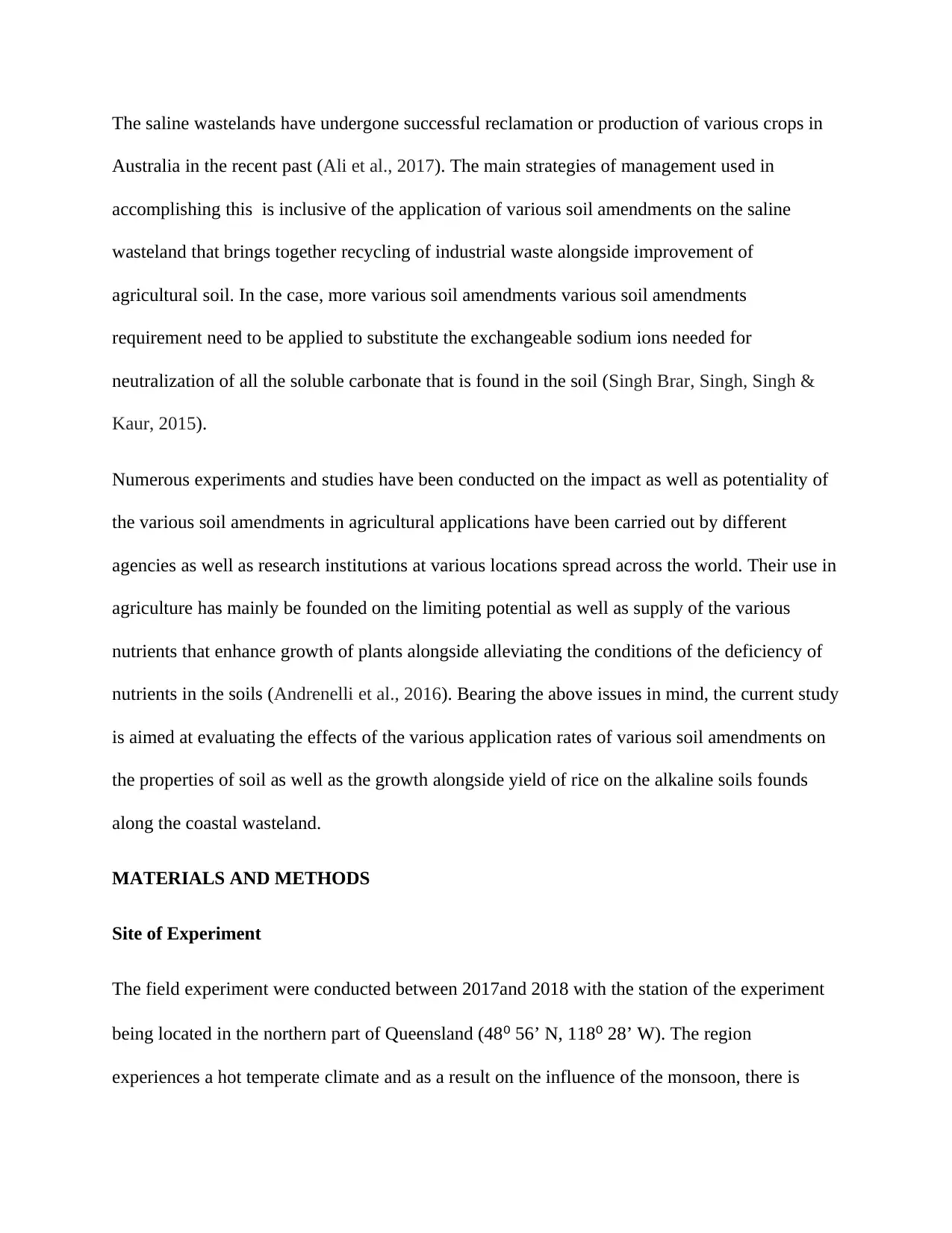
The saline wastelands have undergone successful reclamation or production of various crops in
Australia in the recent past (Ali et al., 2017). The main strategies of management used in
accomplishing this is inclusive of the application of various soil amendments on the saline
wasteland that brings together recycling of industrial waste alongside improvement of
agricultural soil. In the case, more various soil amendments various soil amendments
requirement need to be applied to substitute the exchangeable sodium ions needed for
neutralization of all the soluble carbonate that is found in the soil (Singh Brar, Singh, Singh &
Kaur, 2015).
Numerous experiments and studies have been conducted on the impact as well as potentiality of
the various soil amendments in agricultural applications have been carried out by different
agencies as well as research institutions at various locations spread across the world. Their use in
agriculture has mainly be founded on the limiting potential as well as supply of the various
nutrients that enhance growth of plants alongside alleviating the conditions of the deficiency of
nutrients in the soils (Andrenelli et al., 2016). Bearing the above issues in mind, the current study
is aimed at evaluating the effects of the various application rates of various soil amendments on
the properties of soil as well as the growth alongside yield of rice on the alkaline soils founds
along the coastal wasteland.
MATERIALS AND METHODS
Site of Experiment
The field experiment were conducted between 2017and 2018 with the station of the experiment
being located in the northern part of Queensland (48⁰ 56’ N, 118⁰ 28’ W). The region
experiences a hot temperate climate and as a result on the influence of the monsoon, there is
Australia in the recent past (Ali et al., 2017). The main strategies of management used in
accomplishing this is inclusive of the application of various soil amendments on the saline
wasteland that brings together recycling of industrial waste alongside improvement of
agricultural soil. In the case, more various soil amendments various soil amendments
requirement need to be applied to substitute the exchangeable sodium ions needed for
neutralization of all the soluble carbonate that is found in the soil (Singh Brar, Singh, Singh &
Kaur, 2015).
Numerous experiments and studies have been conducted on the impact as well as potentiality of
the various soil amendments in agricultural applications have been carried out by different
agencies as well as research institutions at various locations spread across the world. Their use in
agriculture has mainly be founded on the limiting potential as well as supply of the various
nutrients that enhance growth of plants alongside alleviating the conditions of the deficiency of
nutrients in the soils (Andrenelli et al., 2016). Bearing the above issues in mind, the current study
is aimed at evaluating the effects of the various application rates of various soil amendments on
the properties of soil as well as the growth alongside yield of rice on the alkaline soils founds
along the coastal wasteland.
MATERIALS AND METHODS
Site of Experiment
The field experiment were conducted between 2017and 2018 with the station of the experiment
being located in the northern part of Queensland (48⁰ 56’ N, 118⁰ 28’ W). The region
experiences a hot temperate climate and as a result on the influence of the monsoon, there is
Paraphrase This Document
Need a fresh take? Get an instant paraphrase of this document with our AI Paraphraser
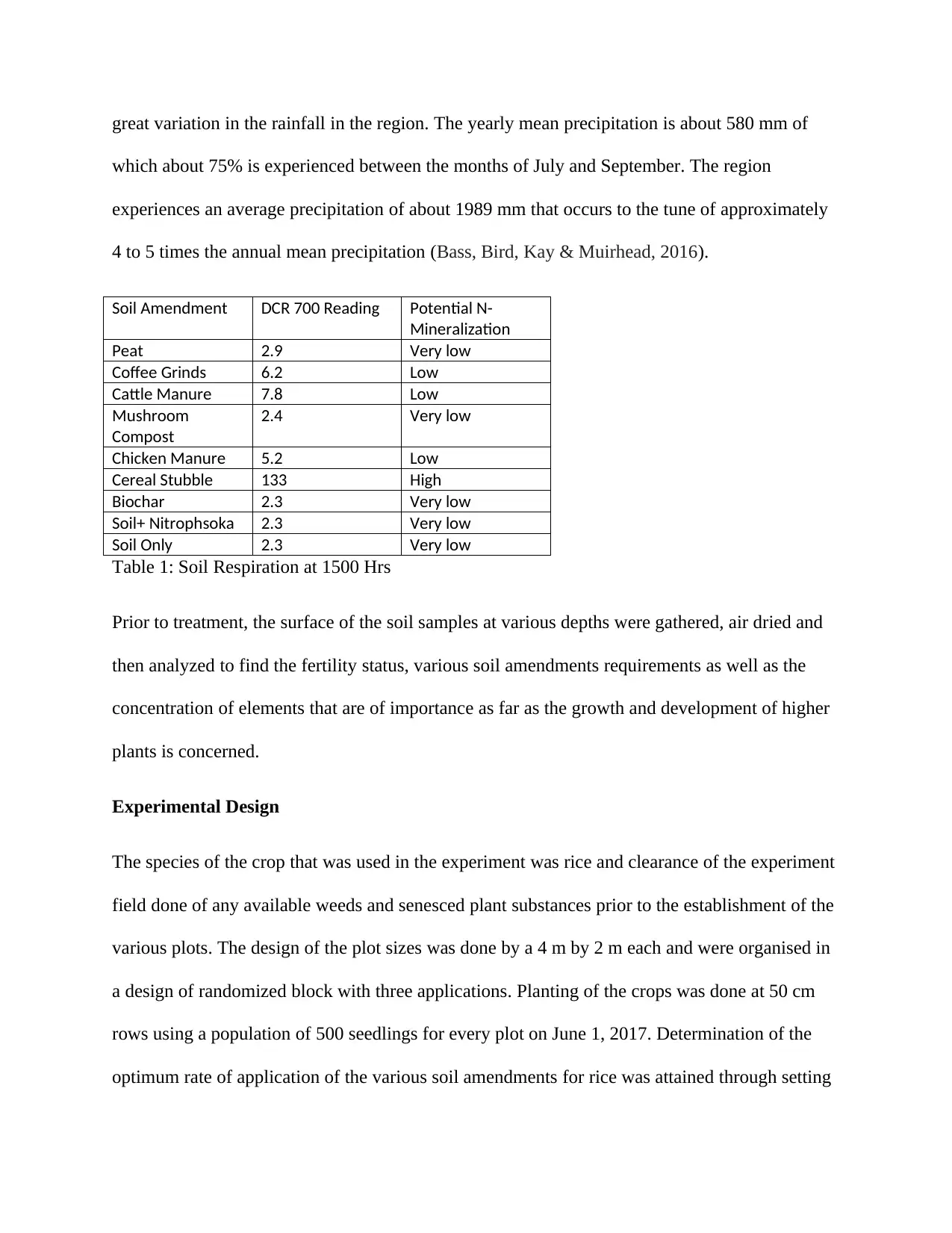
great variation in the rainfall in the region. The yearly mean precipitation is about 580 mm of
which about 75% is experienced between the months of July and September. The region
experiences an average precipitation of about 1989 mm that occurs to the tune of approximately
4 to 5 times the annual mean precipitation (Bass, Bird, Kay & Muirhead, 2016).
Soil Amendment DCR 700 Reading Potential N-
Mineralization
Peat 2.9 Very low
Coffee Grinds 6.2 Low
Cattle Manure 7.8 Low
Mushroom
Compost
2.4 Very low
Chicken Manure 5.2 Low
Cereal Stubble 133 High
Biochar 2.3 Very low
Soil+ Nitrophsoka 2.3 Very low
Soil Only 2.3 Very low
Table 1: Soil Respiration at 1500 Hrs
Prior to treatment, the surface of the soil samples at various depths were gathered, air dried and
then analyzed to find the fertility status, various soil amendments requirements as well as the
concentration of elements that are of importance as far as the growth and development of higher
plants is concerned.
Experimental Design
The species of the crop that was used in the experiment was rice and clearance of the experiment
field done of any available weeds and senesced plant substances prior to the establishment of the
various plots. The design of the plot sizes was done by a 4 m by 2 m each and were organised in
a design of randomized block with three applications. Planting of the crops was done at 50 cm
rows using a population of 500 seedlings for every plot on June 1, 2017. Determination of the
optimum rate of application of the various soil amendments for rice was attained through setting
which about 75% is experienced between the months of July and September. The region
experiences an average precipitation of about 1989 mm that occurs to the tune of approximately
4 to 5 times the annual mean precipitation (Bass, Bird, Kay & Muirhead, 2016).
Soil Amendment DCR 700 Reading Potential N-
Mineralization
Peat 2.9 Very low
Coffee Grinds 6.2 Low
Cattle Manure 7.8 Low
Mushroom
Compost
2.4 Very low
Chicken Manure 5.2 Low
Cereal Stubble 133 High
Biochar 2.3 Very low
Soil+ Nitrophsoka 2.3 Very low
Soil Only 2.3 Very low
Table 1: Soil Respiration at 1500 Hrs
Prior to treatment, the surface of the soil samples at various depths were gathered, air dried and
then analyzed to find the fertility status, various soil amendments requirements as well as the
concentration of elements that are of importance as far as the growth and development of higher
plants is concerned.
Experimental Design
The species of the crop that was used in the experiment was rice and clearance of the experiment
field done of any available weeds and senesced plant substances prior to the establishment of the
various plots. The design of the plot sizes was done by a 4 m by 2 m each and were organised in
a design of randomized block with three applications. Planting of the crops was done at 50 cm
rows using a population of 500 seedlings for every plot on June 1, 2017. Determination of the
optimum rate of application of the various soil amendments for rice was attained through setting
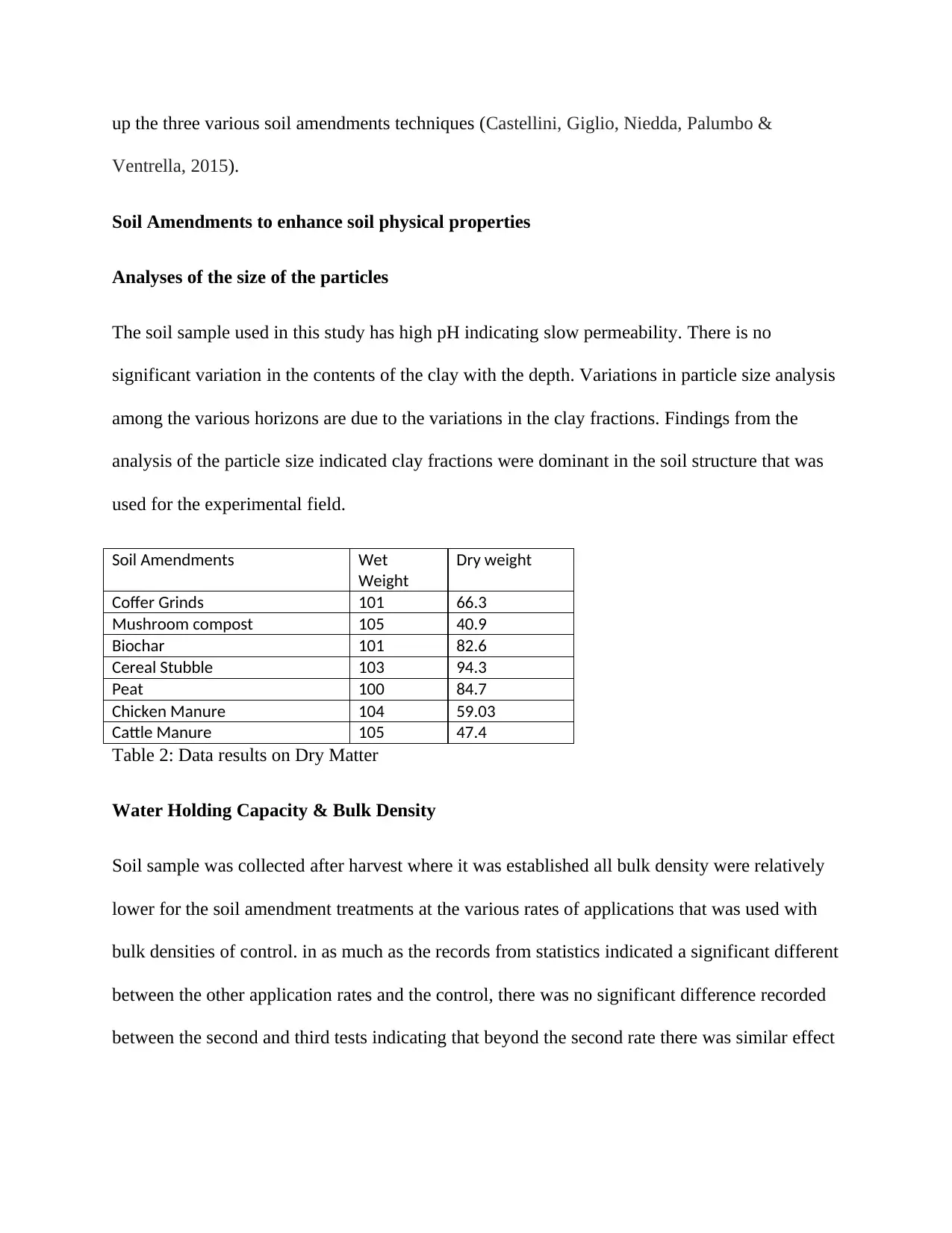
up the three various soil amendments techniques (Castellini, Giglio, Niedda, Palumbo &
Ventrella, 2015).
Soil Amendments to enhance soil physical properties
Analyses of the size of the particles
The soil sample used in this study has high pH indicating slow permeability. There is no
significant variation in the contents of the clay with the depth. Variations in particle size analysis
among the various horizons are due to the variations in the clay fractions. Findings from the
analysis of the particle size indicated clay fractions were dominant in the soil structure that was
used for the experimental field.
Soil Amendments Wet
Weight
Dry weight
Coffer Grinds 101 66.3
Mushroom compost 105 40.9
Biochar 101 82.6
Cereal Stubble 103 94.3
Peat 100 84.7
Chicken Manure 104 59.03
Cattle Manure 105 47.4
Table 2: Data results on Dry Matter
Water Holding Capacity & Bulk Density
Soil sample was collected after harvest where it was established all bulk density were relatively
lower for the soil amendment treatments at the various rates of applications that was used with
bulk densities of control. in as much as the records from statistics indicated a significant different
between the other application rates and the control, there was no significant difference recorded
between the second and third tests indicating that beyond the second rate there was similar effect
Ventrella, 2015).
Soil Amendments to enhance soil physical properties
Analyses of the size of the particles
The soil sample used in this study has high pH indicating slow permeability. There is no
significant variation in the contents of the clay with the depth. Variations in particle size analysis
among the various horizons are due to the variations in the clay fractions. Findings from the
analysis of the particle size indicated clay fractions were dominant in the soil structure that was
used for the experimental field.
Soil Amendments Wet
Weight
Dry weight
Coffer Grinds 101 66.3
Mushroom compost 105 40.9
Biochar 101 82.6
Cereal Stubble 103 94.3
Peat 100 84.7
Chicken Manure 104 59.03
Cattle Manure 105 47.4
Table 2: Data results on Dry Matter
Water Holding Capacity & Bulk Density
Soil sample was collected after harvest where it was established all bulk density were relatively
lower for the soil amendment treatments at the various rates of applications that was used with
bulk densities of control. in as much as the records from statistics indicated a significant different
between the other application rates and the control, there was no significant difference recorded
between the second and third tests indicating that beyond the second rate there was similar effect
⊘ This is a preview!⊘
Do you want full access?
Subscribe today to unlock all pages.

Trusted by 1+ million students worldwide
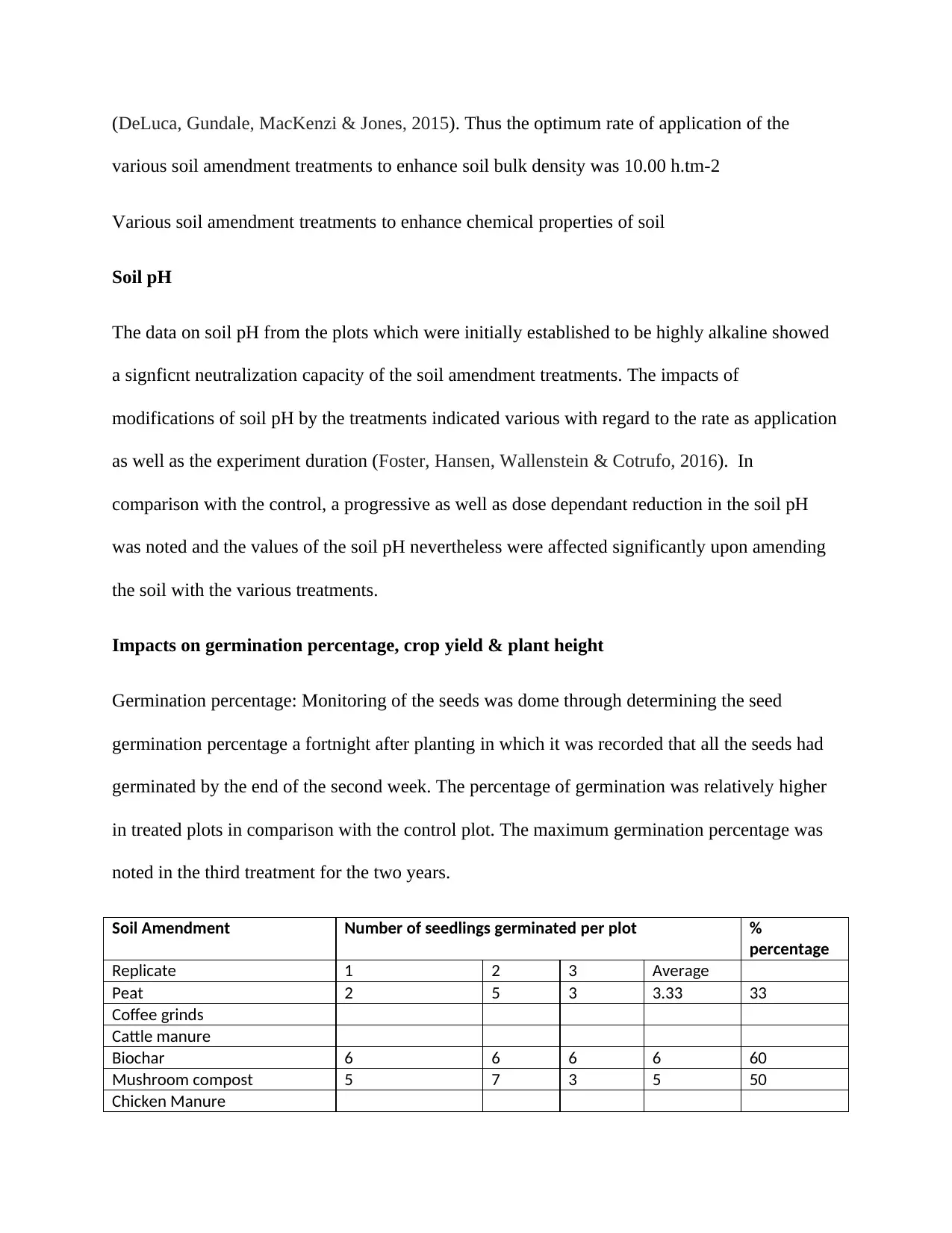
(DeLuca, Gundale, MacKenzi & Jones, 2015). Thus the optimum rate of application of the
various soil amendment treatments to enhance soil bulk density was 10.00 h.tm-2
Various soil amendment treatments to enhance chemical properties of soil
Soil pH
The data on soil pH from the plots which were initially established to be highly alkaline showed
a signficnt neutralization capacity of the soil amendment treatments. The impacts of
modifications of soil pH by the treatments indicated various with regard to the rate as application
as well as the experiment duration (Foster, Hansen, Wallenstein & Cotrufo, 2016). In
comparison with the control, a progressive as well as dose dependant reduction in the soil pH
was noted and the values of the soil pH nevertheless were affected significantly upon amending
the soil with the various treatments.
Impacts on germination percentage, crop yield & plant height
Germination percentage: Monitoring of the seeds was dome through determining the seed
germination percentage a fortnight after planting in which it was recorded that all the seeds had
germinated by the end of the second week. The percentage of germination was relatively higher
in treated plots in comparison with the control plot. The maximum germination percentage was
noted in the third treatment for the two years.
Soil Amendment Number of seedlings germinated per plot %
percentage
Replicate 1 2 3 Average
Peat 2 5 3 3.33 33
Coffee grinds
Cattle manure
Biochar 6 6 6 6 60
Mushroom compost 5 7 3 5 50
Chicken Manure
various soil amendment treatments to enhance soil bulk density was 10.00 h.tm-2
Various soil amendment treatments to enhance chemical properties of soil
Soil pH
The data on soil pH from the plots which were initially established to be highly alkaline showed
a signficnt neutralization capacity of the soil amendment treatments. The impacts of
modifications of soil pH by the treatments indicated various with regard to the rate as application
as well as the experiment duration (Foster, Hansen, Wallenstein & Cotrufo, 2016). In
comparison with the control, a progressive as well as dose dependant reduction in the soil pH
was noted and the values of the soil pH nevertheless were affected significantly upon amending
the soil with the various treatments.
Impacts on germination percentage, crop yield & plant height
Germination percentage: Monitoring of the seeds was dome through determining the seed
germination percentage a fortnight after planting in which it was recorded that all the seeds had
germinated by the end of the second week. The percentage of germination was relatively higher
in treated plots in comparison with the control plot. The maximum germination percentage was
noted in the third treatment for the two years.
Soil Amendment Number of seedlings germinated per plot %
percentage
Replicate 1 2 3 Average
Peat 2 5 3 3.33 33
Coffee grinds
Cattle manure
Biochar 6 6 6 6 60
Mushroom compost 5 7 3 5 50
Chicken Manure
Paraphrase This Document
Need a fresh take? Get an instant paraphrase of this document with our AI Paraphraser
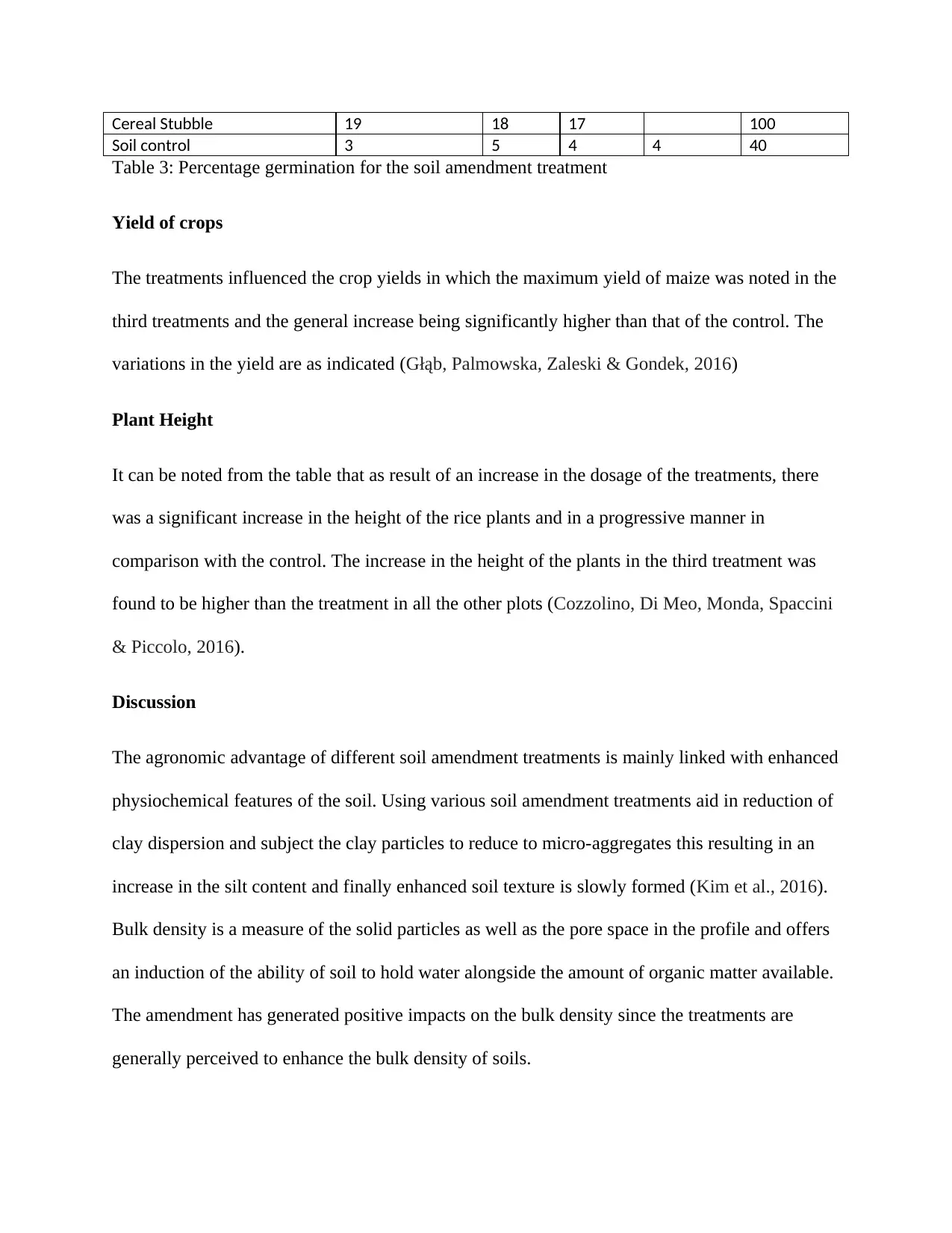
Cereal Stubble 19 18 17 100
Soil control 3 5 4 4 40
Table 3: Percentage germination for the soil amendment treatment
Yield of crops
The treatments influenced the crop yields in which the maximum yield of maize was noted in the
third treatments and the general increase being significantly higher than that of the control. The
variations in the yield are as indicated (Głąb, Palmowska, Zaleski & Gondek, 2016)
Plant Height
It can be noted from the table that as result of an increase in the dosage of the treatments, there
was a significant increase in the height of the rice plants and in a progressive manner in
comparison with the control. The increase in the height of the plants in the third treatment was
found to be higher than the treatment in all the other plots (Cozzolino, Di Meo, Monda, Spaccini
& Piccolo, 2016).
Discussion
The agronomic advantage of different soil amendment treatments is mainly linked with enhanced
physiochemical features of the soil. Using various soil amendment treatments aid in reduction of
clay dispersion and subject the clay particles to reduce to micro-aggregates this resulting in an
increase in the silt content and finally enhanced soil texture is slowly formed (Kim et al., 2016).
Bulk density is a measure of the solid particles as well as the pore space in the profile and offers
an induction of the ability of soil to hold water alongside the amount of organic matter available.
The amendment has generated positive impacts on the bulk density since the treatments are
generally perceived to enhance the bulk density of soils.
Soil control 3 5 4 4 40
Table 3: Percentage germination for the soil amendment treatment
Yield of crops
The treatments influenced the crop yields in which the maximum yield of maize was noted in the
third treatments and the general increase being significantly higher than that of the control. The
variations in the yield are as indicated (Głąb, Palmowska, Zaleski & Gondek, 2016)
Plant Height
It can be noted from the table that as result of an increase in the dosage of the treatments, there
was a significant increase in the height of the rice plants and in a progressive manner in
comparison with the control. The increase in the height of the plants in the third treatment was
found to be higher than the treatment in all the other plots (Cozzolino, Di Meo, Monda, Spaccini
& Piccolo, 2016).
Discussion
The agronomic advantage of different soil amendment treatments is mainly linked with enhanced
physiochemical features of the soil. Using various soil amendment treatments aid in reduction of
clay dispersion and subject the clay particles to reduce to micro-aggregates this resulting in an
increase in the silt content and finally enhanced soil texture is slowly formed (Kim et al., 2016).
Bulk density is a measure of the solid particles as well as the pore space in the profile and offers
an induction of the ability of soil to hold water alongside the amount of organic matter available.
The amendment has generated positive impacts on the bulk density since the treatments are
generally perceived to enhance the bulk density of soils.
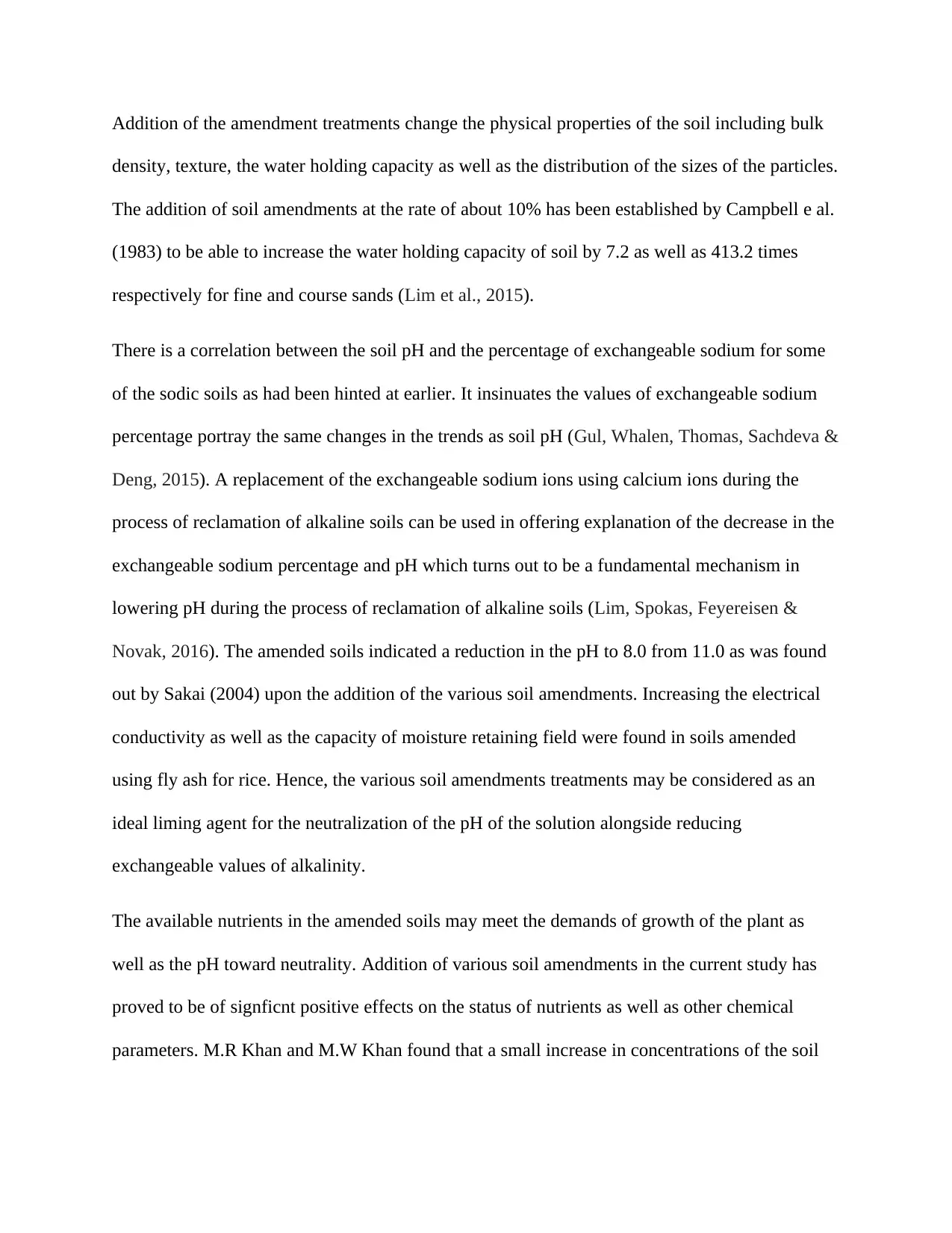
Addition of the amendment treatments change the physical properties of the soil including bulk
density, texture, the water holding capacity as well as the distribution of the sizes of the particles.
The addition of soil amendments at the rate of about 10% has been established by Campbell e al.
(1983) to be able to increase the water holding capacity of soil by 7.2 as well as 413.2 times
respectively for fine and course sands (Lim et al., 2015).
There is a correlation between the soil pH and the percentage of exchangeable sodium for some
of the sodic soils as had been hinted at earlier. It insinuates the values of exchangeable sodium
percentage portray the same changes in the trends as soil pH (Gul, Whalen, Thomas, Sachdeva &
Deng, 2015). A replacement of the exchangeable sodium ions using calcium ions during the
process of reclamation of alkaline soils can be used in offering explanation of the decrease in the
exchangeable sodium percentage and pH which turns out to be a fundamental mechanism in
lowering pH during the process of reclamation of alkaline soils (Lim, Spokas, Feyereisen &
Novak, 2016). The amended soils indicated a reduction in the pH to 8.0 from 11.0 as was found
out by Sakai (2004) upon the addition of the various soil amendments. Increasing the electrical
conductivity as well as the capacity of moisture retaining field were found in soils amended
using fly ash for rice. Hence, the various soil amendments treatments may be considered as an
ideal liming agent for the neutralization of the pH of the solution alongside reducing
exchangeable values of alkalinity.
The available nutrients in the amended soils may meet the demands of growth of the plant as
well as the pH toward neutrality. Addition of various soil amendments in the current study has
proved to be of signficnt positive effects on the status of nutrients as well as other chemical
parameters. M.R Khan and M.W Khan found that a small increase in concentrations of the soil
density, texture, the water holding capacity as well as the distribution of the sizes of the particles.
The addition of soil amendments at the rate of about 10% has been established by Campbell e al.
(1983) to be able to increase the water holding capacity of soil by 7.2 as well as 413.2 times
respectively for fine and course sands (Lim et al., 2015).
There is a correlation between the soil pH and the percentage of exchangeable sodium for some
of the sodic soils as had been hinted at earlier. It insinuates the values of exchangeable sodium
percentage portray the same changes in the trends as soil pH (Gul, Whalen, Thomas, Sachdeva &
Deng, 2015). A replacement of the exchangeable sodium ions using calcium ions during the
process of reclamation of alkaline soils can be used in offering explanation of the decrease in the
exchangeable sodium percentage and pH which turns out to be a fundamental mechanism in
lowering pH during the process of reclamation of alkaline soils (Lim, Spokas, Feyereisen &
Novak, 2016). The amended soils indicated a reduction in the pH to 8.0 from 11.0 as was found
out by Sakai (2004) upon the addition of the various soil amendments. Increasing the electrical
conductivity as well as the capacity of moisture retaining field were found in soils amended
using fly ash for rice. Hence, the various soil amendments treatments may be considered as an
ideal liming agent for the neutralization of the pH of the solution alongside reducing
exchangeable values of alkalinity.
The available nutrients in the amended soils may meet the demands of growth of the plant as
well as the pH toward neutrality. Addition of various soil amendments in the current study has
proved to be of signficnt positive effects on the status of nutrients as well as other chemical
parameters. M.R Khan and M.W Khan found that a small increase in concentrations of the soil
⊘ This is a preview!⊘
Do you want full access?
Subscribe today to unlock all pages.

Trusted by 1+ million students worldwide
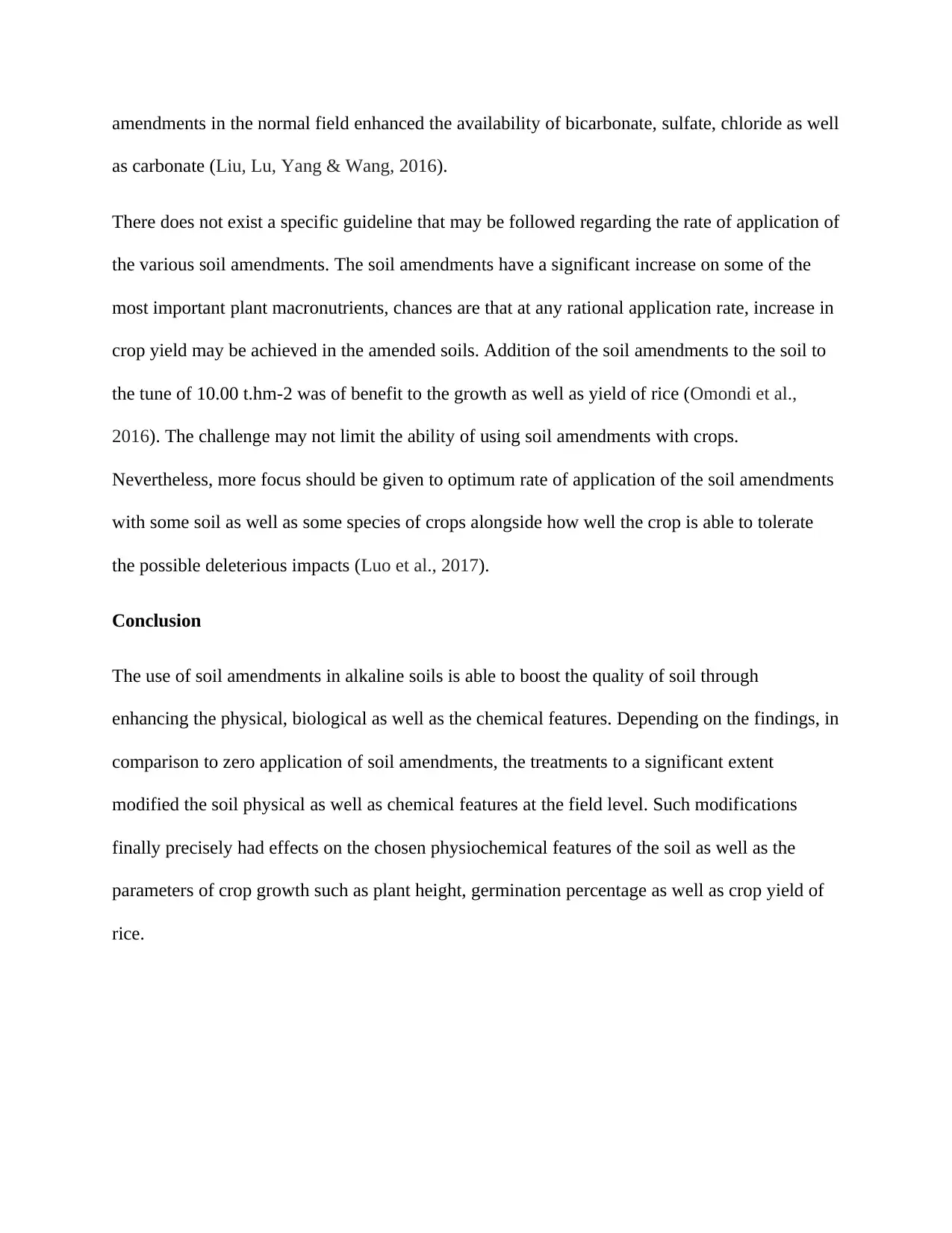
amendments in the normal field enhanced the availability of bicarbonate, sulfate, chloride as well
as carbonate (Liu, Lu, Yang & Wang, 2016).
There does not exist a specific guideline that may be followed regarding the rate of application of
the various soil amendments. The soil amendments have a significant increase on some of the
most important plant macronutrients, chances are that at any rational application rate, increase in
crop yield may be achieved in the amended soils. Addition of the soil amendments to the soil to
the tune of 10.00 t.hm-2 was of benefit to the growth as well as yield of rice (Omondi et al.,
2016). The challenge may not limit the ability of using soil amendments with crops.
Nevertheless, more focus should be given to optimum rate of application of the soil amendments
with some soil as well as some species of crops alongside how well the crop is able to tolerate
the possible deleterious impacts (Luo et al., 2017).
Conclusion
The use of soil amendments in alkaline soils is able to boost the quality of soil through
enhancing the physical, biological as well as the chemical features. Depending on the findings, in
comparison to zero application of soil amendments, the treatments to a significant extent
modified the soil physical as well as chemical features at the field level. Such modifications
finally precisely had effects on the chosen physiochemical features of the soil as well as the
parameters of crop growth such as plant height, germination percentage as well as crop yield of
rice.
as carbonate (Liu, Lu, Yang & Wang, 2016).
There does not exist a specific guideline that may be followed regarding the rate of application of
the various soil amendments. The soil amendments have a significant increase on some of the
most important plant macronutrients, chances are that at any rational application rate, increase in
crop yield may be achieved in the amended soils. Addition of the soil amendments to the soil to
the tune of 10.00 t.hm-2 was of benefit to the growth as well as yield of rice (Omondi et al.,
2016). The challenge may not limit the ability of using soil amendments with crops.
Nevertheless, more focus should be given to optimum rate of application of the soil amendments
with some soil as well as some species of crops alongside how well the crop is able to tolerate
the possible deleterious impacts (Luo et al., 2017).
Conclusion
The use of soil amendments in alkaline soils is able to boost the quality of soil through
enhancing the physical, biological as well as the chemical features. Depending on the findings, in
comparison to zero application of soil amendments, the treatments to a significant extent
modified the soil physical as well as chemical features at the field level. Such modifications
finally precisely had effects on the chosen physiochemical features of the soil as well as the
parameters of crop growth such as plant height, germination percentage as well as crop yield of
rice.
Paraphrase This Document
Need a fresh take? Get an instant paraphrase of this document with our AI Paraphraser
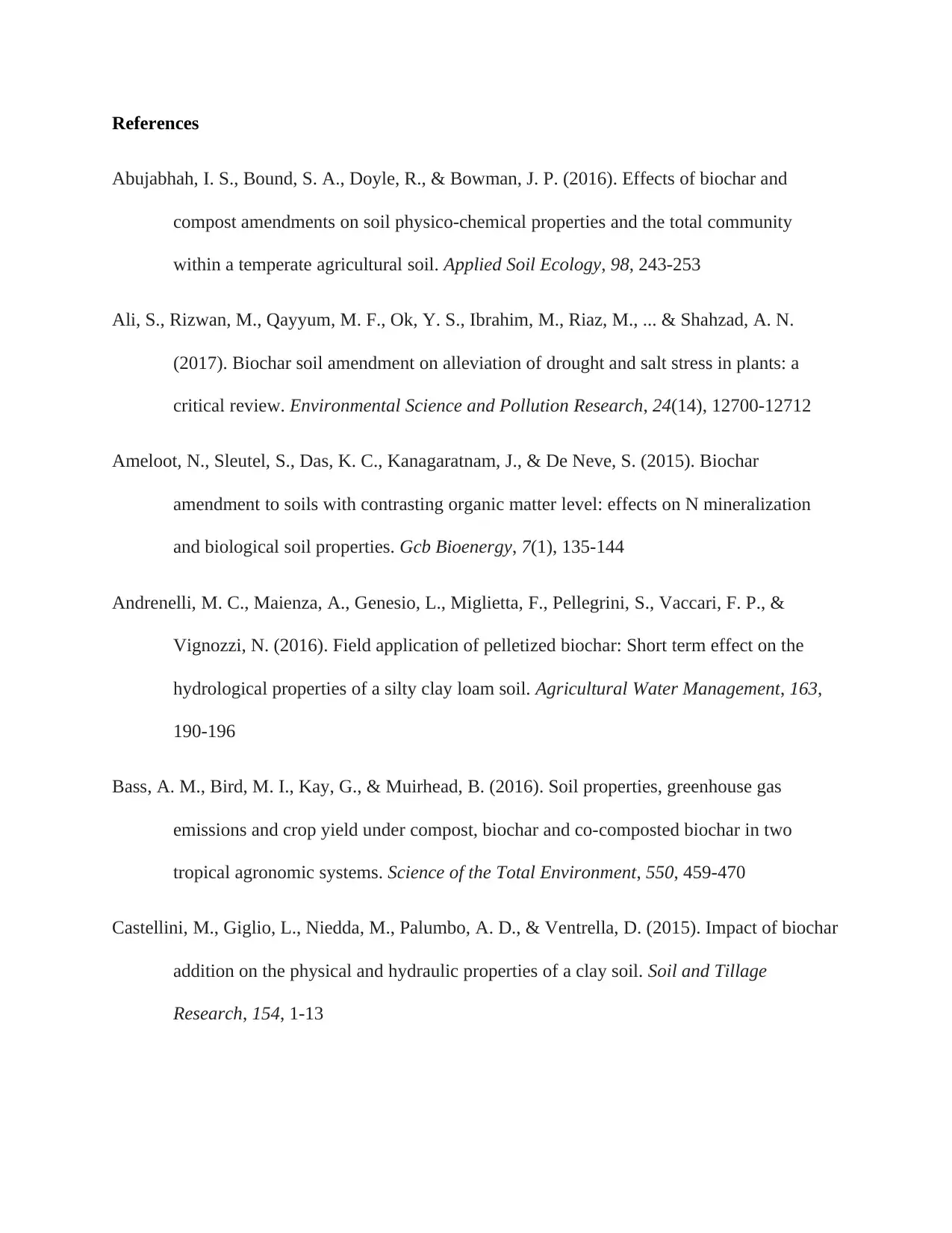
References
Abujabhah, I. S., Bound, S. A., Doyle, R., & Bowman, J. P. (2016). Effects of biochar and
compost amendments on soil physico-chemical properties and the total community
within a temperate agricultural soil. Applied Soil Ecology, 98, 243-253
Ali, S., Rizwan, M., Qayyum, M. F., Ok, Y. S., Ibrahim, M., Riaz, M., ... & Shahzad, A. N.
(2017). Biochar soil amendment on alleviation of drought and salt stress in plants: a
critical review. Environmental Science and Pollution Research, 24(14), 12700-12712
Ameloot, N., Sleutel, S., Das, K. C., Kanagaratnam, J., & De Neve, S. (2015). Biochar
amendment to soils with contrasting organic matter level: effects on N mineralization
and biological soil properties. Gcb Bioenergy, 7(1), 135-144
Andrenelli, M. C., Maienza, A., Genesio, L., Miglietta, F., Pellegrini, S., Vaccari, F. P., &
Vignozzi, N. (2016). Field application of pelletized biochar: Short term effect on the
hydrological properties of a silty clay loam soil. Agricultural Water Management, 163,
190-196
Bass, A. M., Bird, M. I., Kay, G., & Muirhead, B. (2016). Soil properties, greenhouse gas
emissions and crop yield under compost, biochar and co-composted biochar in two
tropical agronomic systems. Science of the Total Environment, 550, 459-470
Castellini, M., Giglio, L., Niedda, M., Palumbo, A. D., & Ventrella, D. (2015). Impact of biochar
addition on the physical and hydraulic properties of a clay soil. Soil and Tillage
Research, 154, 1-13
Abujabhah, I. S., Bound, S. A., Doyle, R., & Bowman, J. P. (2016). Effects of biochar and
compost amendments on soil physico-chemical properties and the total community
within a temperate agricultural soil. Applied Soil Ecology, 98, 243-253
Ali, S., Rizwan, M., Qayyum, M. F., Ok, Y. S., Ibrahim, M., Riaz, M., ... & Shahzad, A. N.
(2017). Biochar soil amendment on alleviation of drought and salt stress in plants: a
critical review. Environmental Science and Pollution Research, 24(14), 12700-12712
Ameloot, N., Sleutel, S., Das, K. C., Kanagaratnam, J., & De Neve, S. (2015). Biochar
amendment to soils with contrasting organic matter level: effects on N mineralization
and biological soil properties. Gcb Bioenergy, 7(1), 135-144
Andrenelli, M. C., Maienza, A., Genesio, L., Miglietta, F., Pellegrini, S., Vaccari, F. P., &
Vignozzi, N. (2016). Field application of pelletized biochar: Short term effect on the
hydrological properties of a silty clay loam soil. Agricultural Water Management, 163,
190-196
Bass, A. M., Bird, M. I., Kay, G., & Muirhead, B. (2016). Soil properties, greenhouse gas
emissions and crop yield under compost, biochar and co-composted biochar in two
tropical agronomic systems. Science of the Total Environment, 550, 459-470
Castellini, M., Giglio, L., Niedda, M., Palumbo, A. D., & Ventrella, D. (2015). Impact of biochar
addition on the physical and hydraulic properties of a clay soil. Soil and Tillage
Research, 154, 1-13
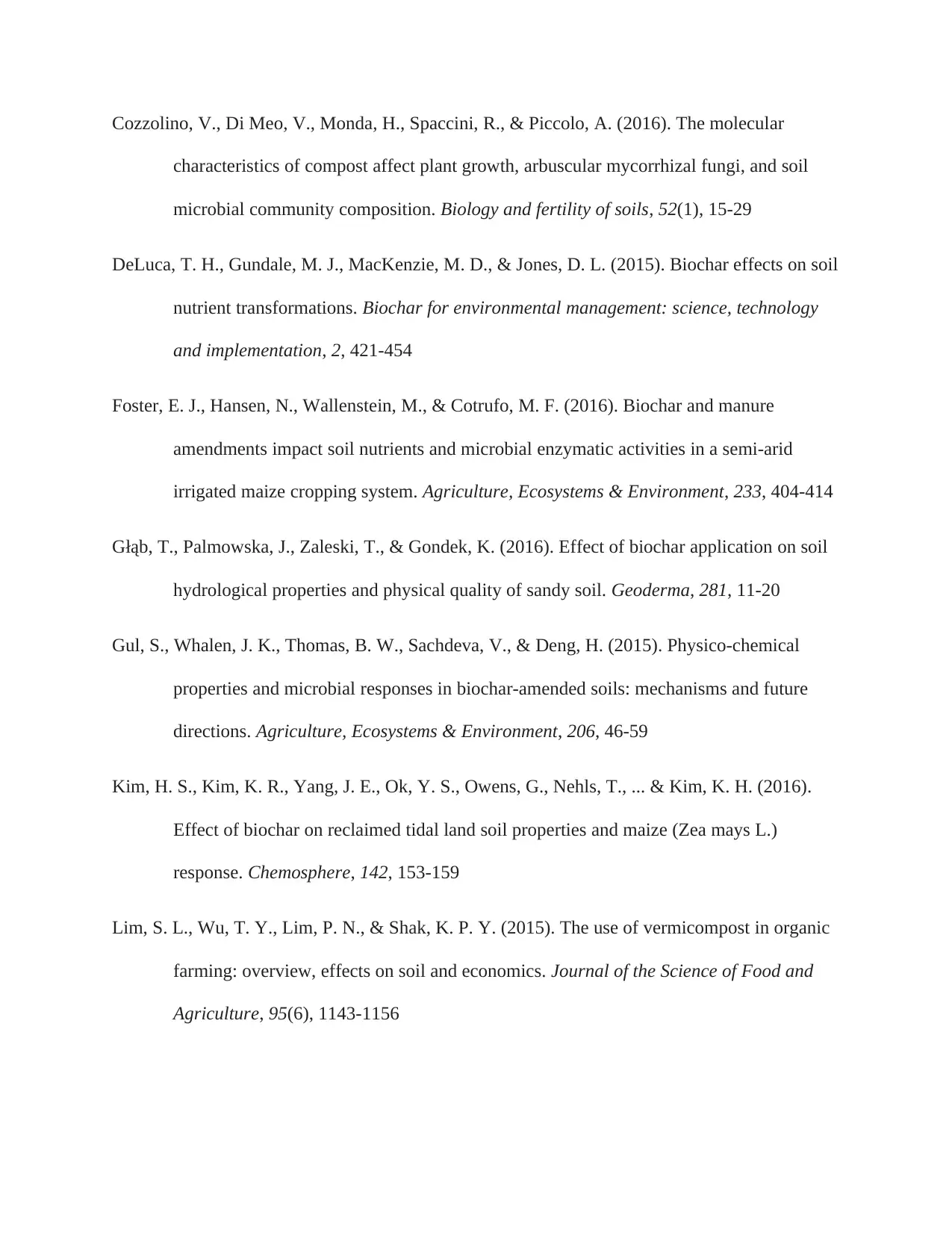
Cozzolino, V., Di Meo, V., Monda, H., Spaccini, R., & Piccolo, A. (2016). The molecular
characteristics of compost affect plant growth, arbuscular mycorrhizal fungi, and soil
microbial community composition. Biology and fertility of soils, 52(1), 15-29
DeLuca, T. H., Gundale, M. J., MacKenzie, M. D., & Jones, D. L. (2015). Biochar effects on soil
nutrient transformations. Biochar for environmental management: science, technology
and implementation, 2, 421-454
Foster, E. J., Hansen, N., Wallenstein, M., & Cotrufo, M. F. (2016). Biochar and manure
amendments impact soil nutrients and microbial enzymatic activities in a semi-arid
irrigated maize cropping system. Agriculture, Ecosystems & Environment, 233, 404-414
Głąb, T., Palmowska, J., Zaleski, T., & Gondek, K. (2016). Effect of biochar application on soil
hydrological properties and physical quality of sandy soil. Geoderma, 281, 11-20
Gul, S., Whalen, J. K., Thomas, B. W., Sachdeva, V., & Deng, H. (2015). Physico-chemical
properties and microbial responses in biochar-amended soils: mechanisms and future
directions. Agriculture, Ecosystems & Environment, 206, 46-59
Kim, H. S., Kim, K. R., Yang, J. E., Ok, Y. S., Owens, G., Nehls, T., ... & Kim, K. H. (2016).
Effect of biochar on reclaimed tidal land soil properties and maize (Zea mays L.)
response. Chemosphere, 142, 153-159
Lim, S. L., Wu, T. Y., Lim, P. N., & Shak, K. P. Y. (2015). The use of vermicompost in organic
farming: overview, effects on soil and economics. Journal of the Science of Food and
Agriculture, 95(6), 1143-1156
characteristics of compost affect plant growth, arbuscular mycorrhizal fungi, and soil
microbial community composition. Biology and fertility of soils, 52(1), 15-29
DeLuca, T. H., Gundale, M. J., MacKenzie, M. D., & Jones, D. L. (2015). Biochar effects on soil
nutrient transformations. Biochar for environmental management: science, technology
and implementation, 2, 421-454
Foster, E. J., Hansen, N., Wallenstein, M., & Cotrufo, M. F. (2016). Biochar and manure
amendments impact soil nutrients and microbial enzymatic activities in a semi-arid
irrigated maize cropping system. Agriculture, Ecosystems & Environment, 233, 404-414
Głąb, T., Palmowska, J., Zaleski, T., & Gondek, K. (2016). Effect of biochar application on soil
hydrological properties and physical quality of sandy soil. Geoderma, 281, 11-20
Gul, S., Whalen, J. K., Thomas, B. W., Sachdeva, V., & Deng, H. (2015). Physico-chemical
properties and microbial responses in biochar-amended soils: mechanisms and future
directions. Agriculture, Ecosystems & Environment, 206, 46-59
Kim, H. S., Kim, K. R., Yang, J. E., Ok, Y. S., Owens, G., Nehls, T., ... & Kim, K. H. (2016).
Effect of biochar on reclaimed tidal land soil properties and maize (Zea mays L.)
response. Chemosphere, 142, 153-159
Lim, S. L., Wu, T. Y., Lim, P. N., & Shak, K. P. Y. (2015). The use of vermicompost in organic
farming: overview, effects on soil and economics. Journal of the Science of Food and
Agriculture, 95(6), 1143-1156
⊘ This is a preview!⊘
Do you want full access?
Subscribe today to unlock all pages.

Trusted by 1+ million students worldwide
1 out of 14
Your All-in-One AI-Powered Toolkit for Academic Success.
+13062052269
info@desklib.com
Available 24*7 on WhatsApp / Email
![[object Object]](/_next/static/media/star-bottom.7253800d.svg)
Unlock your academic potential
Copyright © 2020–2025 A2Z Services. All Rights Reserved. Developed and managed by ZUCOL.

